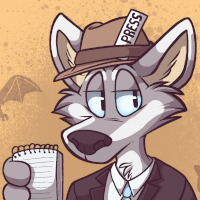Rise of the Silver Moon, by Kuragari Inuken and K. G. Hobbes – book review by Fred Patten.
by Patch O'Furr
Submitted by Fred Patten, Furry’s favorite historian and reviewer.
 Rise of the Silver Moon, by Kuragari Inuken and K. G. Hobbes. Illustrated by Shiki Z. Shigls.
Rise of the Silver Moon, by Kuragari Inuken and K. G. Hobbes. Illustrated by Shiki Z. Shigls.
Las Vegas, NV, Rabbit Valley Books, May 2016, trade paperback $20.00 (177 pages).
This is a Medievalish fantasy adventure with funny-animal warriors and wizards, including “dragonkin”. I’m not sure what the dragonkin are supposed to look like, despite the picture of one on the cover:
“The dragonkin straightened and unfurled his wings briefly, flexing them in the cool night air then folding them against his back. Adjusting his clothes nervously and checking that he was presentable in his reflection from a window he stepped up to the door, and knocked far more quietly than such a large fist would seem to allow.” (pgs. 2-3)
So the dragonkin have large wings plus clothes. How does that work? Are the shirts or tunics backless? If the dragonkin are humanoid, do they sleep on their backs with those wings?
Never mind. For a funny-animal adventure like this, it doesn’t matter.
Khan the dragonkin/dragon is the monk-sensei of a martial-art school. He is determined to climb a cursed mountain for the healing flowers that grow only at its top. The flowers grow at the foot of a stone statue of a humanoid wolf that comes to life when he picks them. After an exhausting fight, Khan throws the wolf off the mountaintop to its death. But when it dies, the wolf’s spirit possesses Khan:
“He felt something bubble up in his chest and rise in his throat, escaping his maw in a loud lupine howl! Khan clapped his hands over his mouth and shivered as he kneeled, feeling extremely weak and shaky. Another howl pierced the now silent night and made the dragon double over retching on his hands and knees.” (p. 19)


 The Origin Chronicles: Mineau, by Justin Reece Swatsworth. Illustrated by the author.
The Origin Chronicles: Mineau, by Justin Reece Swatsworth. Illustrated by the author. The Dragon Tax, by Madison Keller
The Dragon Tax, by Madison Keller Fairytales Written by Rabbits, by Mary A. Parker. Illustrated by Michelle Cannon.
Fairytales Written by Rabbits, by Mary A. Parker. Illustrated by Michelle Cannon. Doglands, by Tim Willocks
Doglands, by Tim Willocks Legacy: Dawn, by Rukis. Illustrated by the author.
Legacy: Dawn, by Rukis. Illustrated by the author. Song of the Summer King, by Jess E. Owen. Map.
Song of the Summer King, by Jess E. Owen. Map. Dream Jumper. Book One, Nightmare Escape, by Greg Grunberg & Lucas Turnbloom.
Dream Jumper. Book One, Nightmare Escape, by Greg Grunberg & Lucas Turnbloom.
 Les Ailes du Singe. T.1, Wakanda, by Étienne Willem.
Les Ailes du Singe. T.1, Wakanda, by Étienne Willem. Franko, Fables of the Last Earth by Cristobal Jofre and Angel Bernier (General
Franko, Fables of the Last Earth by Cristobal Jofre and Angel Bernier (General